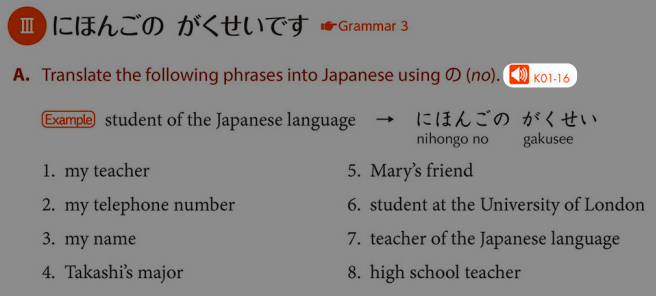Step 2: Learn Basic Grammar
Estimated Time: 6-12 months
Why Study Grammar?
Studying grammar has a bad rap—and for good reason.
When you hear the word “grammar,” you probably think of tedious times spent learning esoteric rules, nitpicking over word choice and punctuation, and being told that there is a “right” way to communicate.
But despite ongoing attempts by the education system to convince us that grammar is important, no one cares about the capitalization of words in titles, dangling modifiers, or Oxford commas—at least no one you want to be friends with.
Because, what’s the point, really? If you can already communicate in a language, studying grammar “rules” isn’t going to make you more fluent. In fact, it will probably make your speech more unnatural.
But while studying grammar will make you sound stiff if you’re already fluent, it has tremendous value when you’re just starting out in a second language like Japanese. That’s because grammar “rules” give you a framework for understanding the unfamiliar.
Grammar rules organize the seeming chaos of a new language and make it comprehensible. While you could eventually learn to recognize language patterns naturally through input, doing so is way less efficient.
So by studying grammar, you’ll get the tools you need to start inputting Japanese on day 1. And because your language skills depend on how many sentences you input, studying grammar rules is the quickest way to build your foundation.
Use a Textbook to Study Grammar
The best way to approach grammar study as a complete beginner is to work through a textbook. As painful as working through a textbook may seem, you can rest assured that completing it will guarantee you’ve got the basic grammar rules down. Here’s why:
First, it’s easy to think passively watching videos or reading explanations is enough to learn grammar. But more often than not, you’ll find that you don’t really understand something until you try putting it into practice. And this is one place where textbooks shine—they prevent the illusion of understanding by forcing you to demonstrate your mastery by working through example problems.
Second, textbooks start with the most basic grammar and build from there. Besides allowing you to put sentences together from day one, this means you will automatically be practicing what you already learned while you pick up new information. By design, you’ll automatically be reinforcing your knowledge and understanding with each successive lesson.
Third, textbooks are conveniently divided up into lessons, and the material in each lesson can be subdivided further. This flexibility means you can make textbook study work with any schedule—no matter how busy.
Last, textbooks allow you to measure your growth, one chapter at a time. Measuring your own progress may not seem like a big deal, but it is. Sensing how you are improving is crucial to helping sustain your language study habit, especially when you are a beginner and everything is difficult, painful, and boring.
Fortunately for you, many of the discouraging aspects of grammar study can be mitigated. And that starts with choosing the right textbook.
Which Textbook To Use: Genki
The textbook you’ll be using to learn the basics of Japanese grammar is げんき (Genki).
Note: Use the Digital Textbook
I recommend getting a digital copy of Genki because the convenience of being able to complete your daily tasks on your phone will make it easier to complete your studies. You can follow these links to get a digital copy of Genki 1 or Genki II.
As you will see, the internet resources for Genki make it very easy to study on your phone, which is ideal if you are busy. Don’t let the inconvenience of physical textbooks prevent you from achieving your goals!
While there are many introductory textbooks out there you can use to learn basic grammar, Genki is the best choice for self-study. That’s because Genki is the most popular textbook. And that means there are a lot of great (and free!) resources out there to make self-study with Genki as painless and easy as possible.
Like most textbooks, Genki is NOT designed to be a self-study tool. It was designed to be taught by a teacher in a classroom setting. This means certain aspects of Genki don’t crossover to self-study well. You won’t have a teacher to help introduce grammar points. And you won’t be able to execute all of the exercises in the book as intended because they often require working in groups or pairs.
Fortunately, you have the internet.
And in particular, you have the following resources that will make getting through Genki much easier: ToKini Andy on YouTube, who will explain the grammar points in each chapter of Genki, Seth Clydesdale’s website, which has interactive exercises for all textbook and workbook exercises, and the official companion website for Genki, which has videos for each lesson’s dialogue and grammar points.
By using these resources, you’ll get the benefit of Genki as taught in school without the downsides of a classroom setting—rigid class schedules, in-person requirements, and tests. So let’s talk about getting started.
Note For Non-Beginners
Working through Genki is only necessary if you have never worked through a Japanese textbook before. Genki is not the only one—Minna No Nihongo is another common textbook series that covers basic grammar. If you’ve gone through a textbook before, please go here to find a list of all the grammar you’ll need to know courtesy of Tae Kim who will explain/refresh these grammar rules for you.
How Genki Is Structured
Genki has a total of 24 lessons that are divided into 2 books—Genki I and Genki II. Together these textbooks cover all the major grammar rules in Japanese.
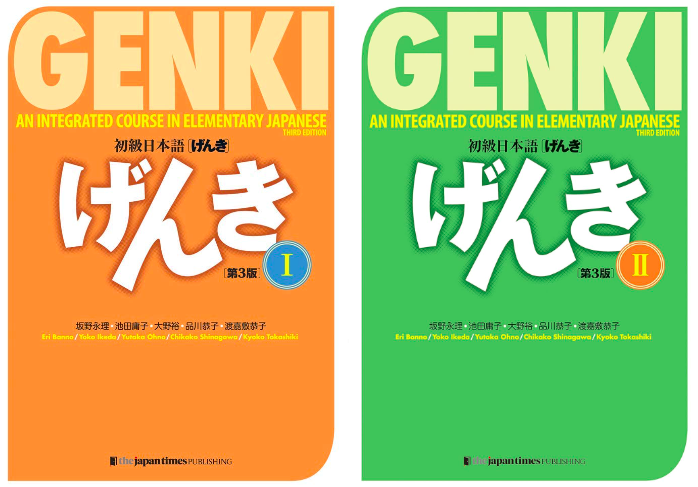
Genki I covers Lessons 0 through 12, while Genki II covers Lessons 13 through 23.
In addition to the textbook, Genki has workbooks to accompany Genki I and Genki II, a separate answer key for all practice exercises, and accompanying audio files.
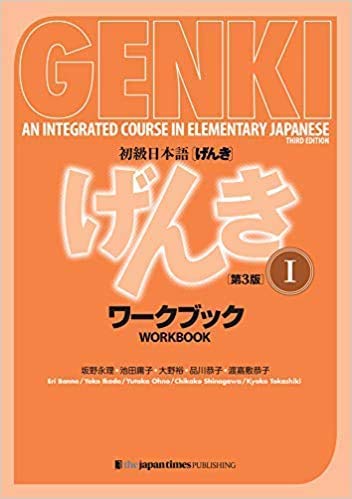
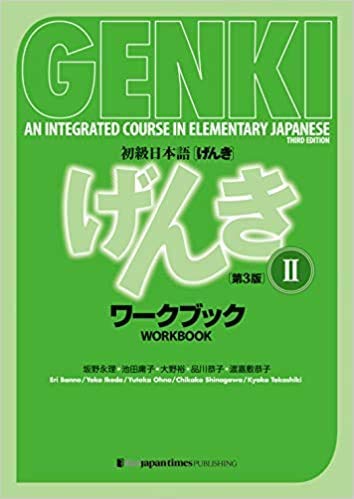
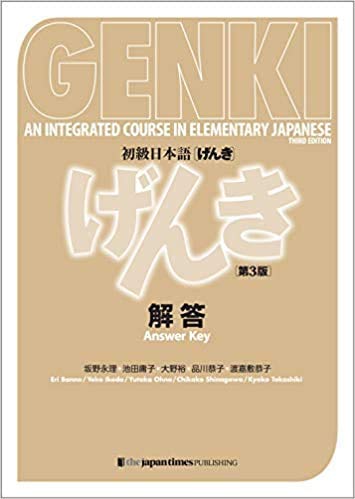
Genki starts by teaching hiragana and katakana, as well as common greetings and basic numbers in Lesson 0. But once you begin Lesson 1, you will find that each lesson is organized in the same way, split between Conversation and Grammar, and Reading and Writing:

Learning how to use Genki isn’t obvious from the structure alone—should you start with the dialogue? Do you need to memorize each lesson’s vocabulary? And when should you do the workbook examples?
While there are many ways to approach Genki, if your goal is reading manga and you will be self-studying, I recommend following the approach below.
Follow a Study Plan
Genki I and II Study Course
I have put together an email study course that covers both Genki I and II and follows the study plan outlined below. If you want to save yourself the effort of figuring out what to study each day, please check out the course! You can also view the study plan here if you would like to study at your own pace.
The first thing you can do to set yourself up for success when using Genki is to follow a study plan. To make this easy, I recommend you divide each lesson in Genki into 8 parts:
- Vocabulary
- Dialogue
- Grammar Introduction (Video + Text)
- Grammar Practice – Textbook
- Grammar Practice – Workbook
- Reading and Writing Practice – Textbook
- Reading and Writing Practice – Workbook
- Video Review
Dividing Genki lessons in this way allows you to study the material in 4 blocks, with each block allocated to a particular day of the week. This gives you 3 days of buffer each week for “catch up” in case you can’t get through all the material on your designated days.
If you have the time in your schedule to crank through 1 Genki lesson each week—the fastest I recommend going—you should group your study as follows:
Day 1: Vocabulary, Dialogue, and Grammar Introduction (Video + Text)
Day 2: Grammar Practice – Textbook
Day 3: Grammar Practice – Workbook
Day 4: Reading and Writing Practice – Textbook and Workbook, Video Review
If you are more time-limited, you can divide the lesson into 8 blocks. This allows you to complete 1 lesson every 2 weeks (4 blocks each week). In that case, I recommend grouping your study as follows:
Day 1: Vocabulary, Dialogue, and Grammar Introduction (Video)
Day 2: Grammar Introduction (Text)
Day 3: Grammar Practice – Textbook Part I
Day 4: Grammar Practice – Textbook Part II
Day 5: Grammar Practice – Workbook Part I
Day 6: Grammar Practice – Workbook Part II
Day 7: Reading and Writing Practice – Textbook and Workbook
Day 8: Video Review
If you go through 1 lesson each week, you will be covering all of Genki I and II in about 6 months. At the rate of 1 lesson every 2 weeks, you will cover all of Genki I and II in 1 year.
Either way, you will be flying through Genki. For reference, colleges typically teach Genki I and II over 4 semesters—or 2 years. So even at the more paced rate of 1 lesson every 2 weeks, you’ll be going twice as fast as the college course.
If that sounds like a big time commitment, don’t worry! You will be able to fly through Genki without spending an unreasonable amount of time because you will be omitting some of the more tedious and time-intensive aspects of the traditional, classroom approach to study.
Avoid Studying Kanji and Memorizing Vocabulary
If you study Genki in college, you will be forced to memorize the vocabulary that each lesson introduces as well as learn the kanji that are introduced in every chapter. That’s because both will be on the test.
But this isn’t school. There is no test. And your goal is to learn how to put Japanese sentences together. Anything that is unnecessary and slows down your ability to study grammar should be avoided.
As you will see in Step 3, learning kanji is not a prerequisite for reading manga and there are faster ways of learning kanji than following the approach taught in Genki. This means you should cut out all kanji study from Genki, which removes all of the writing from the “Reading and Writing” sections starting with Lesson 3.
As you will see in Step 4, it only makes sense to approach a dedicated study of vocabulary once you can understand complex grammar. That’s because the best way to learn vocabulary is by reviewing contextual sentences in a spaced repetition system. And you won’t have exposure to the grammar you need until after you complete Genki.
But more importantly, memorizing vocabulary is not a prerequisite to learning grammar. Sure, you’ll need to know what a word means to understand a sentence that uses it. But there is no need to memorize a word when you can quickly look it up.
So don’t worry about trying to memorize each word you encounter in Genki. In fact, you’ll learn a lot of vocabulary just because the words used in Genki are limited and often repeated. This will provide plenty of “natural” spaced repetition. And you will quickly pick up whatever vocabulary you don’t naturally memorize in Step 4.
Practice Output for Comprehension Not Perfection
Genki aims to teach output skills—speaking and writing—in addition to input skills—listening and speaking. While your goal is to read manga, which does not require you to have mastery over speaking and writing, it is good to engage in all the exercises that Genki provides, even those focused on output.
At this early stage in your language journey, all the exercises will help you understand and practice grammar points. This makes going through each exercise valuable. But this doesn’t mean you need to “master” the skills required for these exercises.
For instance, you’ll come across exercises that ask you to read aloud:

Reading aloud will help you remember the point the textbook is trying to teach you, which here is how to say telephone numbers. So definitely try reading this aloud while listening to the audio file.
But don’t aim to perfectly match the native Japanese audio. This is “shadowing,” and allows you to correct your pronunciation and intuit pitch accent. Shadowing is invaluable if your goal is to improve your ability to speak Japanese. But your goal (at least right now) should be to understand grammar.
And going through the audio multiple times to try and match the accent of a native speaker is not a good use of your time, because the bulk of the benefit comes from the first time you work through the exercise.
Similarly, Genki has exercises that require you to write in Japanese:
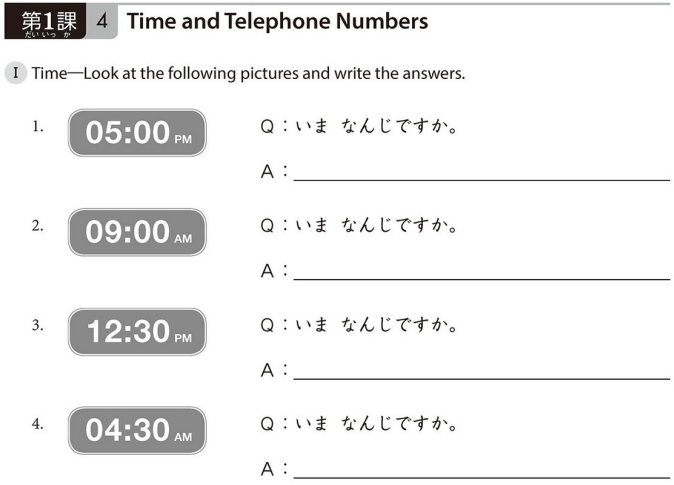
You should definitely attempt these questions, and understand the answers if you didn’t get the answer right. But if the only error in your answer is that you misspelled a word, don’t sweat it. Your goal is to read, not to write.
When you encounter exercises that require you to speak or write, treat it as a different way to comprehend the material. But don’t spend time trying to perfect your responses.
Mastering output is not necessary to cultivate an understanding of Japanese. And because your goal is reading manga, spending time developing skills you don’t need and that won’t help you understand Japanese any faster is not in your best interest.
However, the same is not true for listening and reading practice. You should complete every listening and reading exercise and not move on until you have complete comprehension.
Understanding what you are reading is critical because this is the key skill you’ll need for reading manga. But just because your goal is to read manga doesn’t mean you can or should skip listening exercises.
Taking the time to listen to the audio recording for each exercise will help reinforce your understanding of Japanese grammar by requiring you to input Japanese in a different form. But more importantly, listening will correct any mistakes in your reading that you might not otherwise catch.
This means you should listen to the audio for every exercise in the textbook and workbook when provided. You’ll know an audio option is available when you see this icon:
